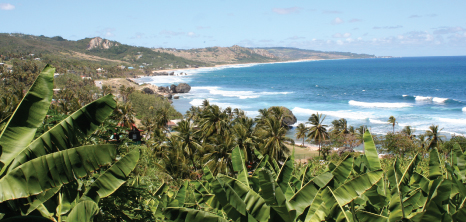|
Barbados' Political HistoryForegoing the Independence of Barbados in 1966, 1639 saw the formation of the country's first body of representatives. A group of sixteen (16) land-owners were chosen to establish the House of Burgesses which soon became the House of Assembly. Candidates for the House of Burgesses were required to be property owners until the Representation of the People (Amendment) Act of 1950 gave to all persons aged 21 and over the right to vote without any income or property qualification and to contest elections also without any income or property qualification. The income and property qualifications were progressively lowered until the last modification in 1943. The island remained a British Colony until Independence. In fact it was not until the introduction of universal adult suffrage that the merchant classes ceased to dominate politics. The black population could not vote until 1831 and it was not until 1840 before one sat in the legislature. Barbados was divided into its current 11 parishes in 1645 with each parish having (2) representatives for the House of Assembly. During 1652 Col. Thomas Modyford was the designated first Speaker of the House of Assembly. After this two Houses of Parliament sat separately, the Legislative Council and the House of Assembly. Eventually the meetings of the Council were held for several years at the official residence of the Governor.
The Governor of Barbados was the colonial head between the 1800s and the 1900s as Barbados was the main Government for the British colonies of the Windward Islands. In 1885 Grenada was left as the colonial head after Barbados pulled out from the Windward Island Union. It was subsequently invalidated.
After Barbados' departure with the Windward Islands, it feverishly examined the possibility of Tobago joining its political union but attempts proved futile. It was warded to Trinidad by the British Government.
The Democratic League was formed in the 1920s by Charles Duncan O'neal and this created a heavy political trigger amongst blacks in Barbados. Political life in Barbados was predominantly controlled by the Barbados Labour Party up until 1961 when it conceded defeat to the Democratic Labour Party.
Grantley Adams, who was one of the leaders of the Trade Unions at the time, established the Barbados Progressive League in 1938, which later became the Barbados Labour Party (BLP). This establishment gained him exceptional social and constitutional reforms.
The descendants of free slaves formed movements for political rights that saw the introduction of Trade Unions in the 1930s. Preceeding this era, Barbados was politically contrlled by merchants.
In 1958, Grantley Adams became the first Premier of Barbados with the island becoming part of a ten (10) member West Indies Federation. This association lasted up until 1962 after which time it failed. Further attempts by Adams to form other Federations were unsuccessful and as a result, Barbados returned to being a Self-governing Colony.
Grantley Adams was replaced by Errol Barrow and in June 1966, Barbados was most effective in bargaining its own independence at a constitutional conference with the United Kingdom. These negotiations allowed Barbados to become an independent state within the Commonwealth of Nations on November 30, 1966. This appointment made Errol Barrow Barbados' first Prime Minister.
Barbados' Political PartiesBarbados has had two (2) main political parties since the time of Independence in 1966. There are the Barbados Labour Party (BLP) and the Democratic Labour Party (DLP) which are both democratic parties with strong affiliations with the British labour movement.
From 1966 - 1976 the Democratic Labout Party, under the leadership of Errol Barrow, had a large following.
From 1976 - 1981 the Barbados Labour Party, under the leadership of Mr. J.M.G.M. Tom Adams, son of Sir Grantley Adams, won back the General Elections with seventeen (17) seats out ot twenty-seven (27).
From 1981 - 1986 the Barbados Labour Party held office for a second term.
In 1985, Barbados was thrown into shock at the untimely death of Mr. J.M.G.M. Tom Adams. After his death, Mr. Harold Bernard "Bree" St. John, Deputy Prime Minister, took up the leadership of the Barbados Labour Party and the office of Prime Minister.
In 1986, under the leadership of Errol Barrow, the Democratic Labour Pary returned to power. As a result of Barrow's death in 1987, Mr. Erskine Sandiford took over and became the country's fourth Prime Minister.
In 1991 the Democratic Labour Party won elections under the leadership of Erskine Sandiford.
In 1994 the Barbados Labour Party won the elections under the leadership of Mr. Owen Arthur.
In 2003, under the leadership of Owen Arthur, the Barbados Labour Party won the elections with a twenty three (23) to seven (7) victory.
In 2008 the Democratic Labour Party, under the leadership of David Thompson, won twenty (20) seats to ten (10).
General Elections in BarbadosGeneral Elections in Barbados are held on Election Day and is a process in which the electorate casts votes in order to democratically elect candidates to fill offices within the House of Assembly.
There is no fixed date set for General Elections in Barbados but they must be called five (5) years after the opening of Parliament following the last election.
|



